Superconducting Devices: Principles, Types, and Applications
Introduction
Superconductivity is one of the most fascinating phenomena in physics and engineering. Discovered by Heike Kamerlingh Onnes in 1911, superconductivity refers to the complete disappearance of electrical resistance in certain materials when cooled below a critical temperature. Most metals decrease electrical resistance with decreasing temperature. Though, most do not decrease to zero resistance as 0 Kelvin is approached. Mercury is unique in that its resistance abruptly drops to zero Ω at 4.2 K. Superconductors lose all resistance abruptly when cooled below their critical temperature, Tc . This remarkable property has paved the way for a wide range of superconducting devices that are revolutionizing fields such as electronics, power systems, medical imaging, and quantum computing.
What Are Superconducting Devices?
Superconducting devices are electronic components or systems that exploit the zero-resistance and quantum mechanical properties of superconductors. Unlike conventional devices, these systems can carry extremely high currents without energy loss, operate at ultra-high speeds, and exhibit unique effects like magnetic flux quantization and the Josephson effect. Super conductors include lead (Pb), aluminum, (Al), tin (Sn) and niobium (Nb).
Key Principles Behind Superconducting Devices
-
Zero Electrical Resistance
Superconductors allow current to flow indefinitely without energy dissipation, enabling ultra-efficient devices. -
Meissner Effect
Superconductors expel magnetic fields when cooled below their critical temperature, which allows for levitation and magnetic shielding applications. -
Quantum Effects
Superconducting devices exploit quantum phenomena such as tunneling and flux quantization, leading to innovations in precision measurement and computing.
Types of Superconducting Devices
1. Josephson Junctions
- A Josephson Junction is a fundamental superconducting device made of two superconductors separated by a very thin barrier, which can be either an insulator, a normal metal, or a weak link. It is named after Brian D. Josephson, who predicted its behavior in 1962.
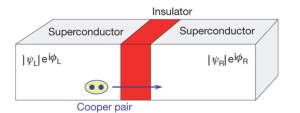
-
Structure of a Josephson Junction
-
Superconductor–Insulator–Superconductor (SIS): The most common type, where a very thin insulating layer allows quantum tunneling of Cooper pairs.
-
Superconductor–Normal metal–Superconductor (SNS): Uses a normal metal layer instead of an insulator.
-
Weak link Josephson Junctions: Use constrictions or other weak coupling regions.
-
-
Working Principle
The Josephson Junction is based on Cooper pair tunneling:
-
In superconductors, electrons form bound pairs called Cooper pairs.
-
Even though an insulating barrier exists, these pairs can tunnel through it without resistance due to quantum mechanics.
-
This tunneling current depends on the phase difference of the superconducting wavefunctions across the junction.
-
-
Applications of Josephson Junctions
-
Superconducting Quantum Interference Devices (SQUIDs): Ultra-sensitive magnetometers.
-
Quantum Computing: Basis for superconducting qubits.
-
High-Speed Digital Circuits: Used in Single Flux Quantum (SFQ) logic.
-
Voltage Standards: Provide the most accurate way to define and measure voltage.
-
Radiation Detectors & Mixers: Detect microwave and terahertz signals.
-
2. SQUIDs (Superconducting Quantum Interference Devices)
-
A SQUID (Superconducting Quantum Interference Device) is an extremely sensitive magnetometer that uses superconducting loops with Josephson junctions to detect very small changes in magnetic fields. SQUIDs are among the most precise instruments for measuring magnetic flux.
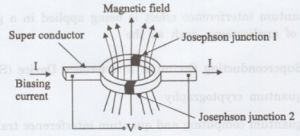
-
DC SQUID – Has two Josephson junctions in parallel within the superconducting loop.
-
RF SQUID – Has one Josephson junction and works with radio-frequency excitation.
Structure of a SQUID
A SQUID typically consists of:
-
A superconducting loop (usually made of niobium or another superconductor).
-
One or two Josephson junctions embedded in the loop.
Depending on the number of junctions, there are two main types:
-
-
-
Working Principle of SQUIDs
The SQUID operates on two key principles:
-
Josephson Effect
-
Cooper pairs tunnel through Josephson junctions, producing a current that depends on the phase difference of the superconducting wavefunctions.
-
-
Flux Quantization
-
Magnetic flux through a superconducting loop is quantized in units of the flux quantum (Φ0=h/2e).
-
When an external magnetic field is applied, it changes the phase difference across the junctions. This modifies the supercurrent in the loop in a periodic way.
-
As a result, the current or voltage response of the SQUID oscillates with changes in the magnetic flux. By monitoring this response, extremely small magnetic fields can be detected.
-
-
Applications of SQUIDs
-
Medical Diagnostics
-
Magnetoencephalography (MEG): Detects tiny magnetic fields generated by neural activity in the brain.
-
Magnetocardiography (MCG): Measures weak magnetic fields from the heart.
-
-
Geophysics and Exploration
-
Used to detect mineral deposits and oil reserves by mapping subtle magnetic variations in the Earth.
-
-
Fundamental Physics
-
Measurement of small magnetic moments, nuclear magnetic resonance (NMR), and gravitational wave detection experiments.
-
-
Material Science
-
Characterizing superconductors and magnetic materials at very low field levels.
-
-
Quantum Computing
-
SQUIDs are used as readout devices for superconducting qubits.
-
-
3. Superconducting Magnets
-
A Superconducting Magnet is a powerful electromagnet made from superconducting wire that, when cooled below its critical temperature, carries large electric currents without resistance. Because there is no resistive heating, superconducting magnets can generate extremely strong, stable magnetic fields far more efficiently than conventional copper or aluminum-based electromagnets.
-
Structure of a Superconducting Magnet
-
Superconducting wire or tape (commonly made of Niobium-Titanium (NbTi), Niobium-Tin (Nb3_3Sn), or high-temperature superconductors like YBCO).
-
Cryogenic system (liquid helium or liquid nitrogen) to keep the material below its superconducting transition temperature.
-
Magnet coil wound with superconducting wire, often stabilized with copper or other metals for mechanical strength.
-
-
Working Principle
-
When the superconducting wire is cooled below its critical temperature, it enters the superconducting state with zero electrical resistance.
-
A current introduced into the coil continues to flow indefinitely without decay.
-
This produces a constant magnetic field with high efficiency.
-
Since no energy is lost as heat, the magnet can sustain very strong fields (several Tesla) with minimal power input (only the cryogenic cooling consumes energy).
-
-
Applications of Superconducting Magnets
-
Medical Technology
-
MRI (Magnetic Resonance Imaging) Machines – use strong, stable fields (1.5 to 7 Tesla) to image tissues in the human body.
-
-
Scientific Research
-
Particle accelerators (e.g., CERN’s Large Hadron Collider) rely on superconducting magnets to bend and focus particle beams.
-
Nuclear Magnetic Resonance (NMR) Spectroscopy for molecular structure analysis.
-
-
Energy and Power Systems
-
Magnetic confinement in fusion reactors (like ITER) uses superconducting magnets to contain plasma.
-
-
Transportation
-
Maglev trains use superconducting magnets for frictionless high-speed levitation and propulsion.
-
-
Fundamental Physics Experiments
-
Used in studies requiring ultra-strong magnetic fields, such as probing exotic materials and quantum effects.
-
-
4. Superconducting Power Devices
-
Superconducting Power Devices are advanced electrical components that use superconducting materials to improve the efficiency, reliability, and performance of power systems. Because superconductors have zero electrical resistance below their critical temperature, they can carry very high currents without energy loss, making them ideal for applications in power generation, transmission, and distribution.
-
Types of Superconducting Power Devices
1. Superconducting Power Cables
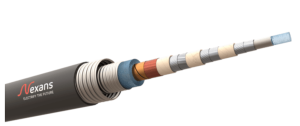
-
-
Can transmit electricity over long distances with virtually no energy loss.
-
Compact and capable of carrying much higher current densities than copper cables.
-
Useful in urban power grids where space is limited.
2. Superconducting Fault Current Limiters (SFCLs)
-
Protect power systems by limiting sudden surges (fault currents) without damaging equipment.
-
Unlike conventional limiters, they react almost instantly and reset automatically.
3. Superconducting Transformers
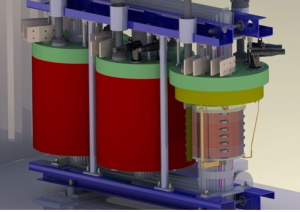
-
-
-
More efficient and lighter than conventional transformers.
-
Provide low-loss operation and reduced size, making them attractive for smart grids.
4. Superconducting Motors and Generators
-
Deliver higher efficiency, smaller size, and lighter weight compared to traditional machines.
-
Suitable for industrial use, naval propulsion systems, and renewable energy generation.
5. Superconducting Magnetic Energy Storage (SMES)
-
Stores energy in the magnetic field created by a superconducting coil.
-
Offers very fast response times and high efficiency, ideal for stabilizing power grids.
-
-
Applications of Superconducting Power Devices
-
Electric Power Grids
-
Lossless transmission and efficient distribution.
-
Improved fault protection and reliability.
-
-
Renewable Energy Integration
-
Efficiently handle variable loads from wind and solar power.
-
-
Industrial Systems
-
High-power motors and generators for ships, factories, and large-scale machinery.
-
-
Energy Storage
-
SMES systems for stabilizing frequency and voltage in modern grids.
-
-
5. Single-Flux Quantum (SFQ) Circuits
-
A Single-Flux Quantum (SFQ) Circuit is a type of superconducting digital circuit that uses the quantum property of magnetic flux quantization to represent and process digital information. Instead of using voltage levels (like CMOS circuits), SFQ circuits encode binary data in the presence or absence of a magnetic flux quantum (Φ0\Phi_0) in a superconducting loop.
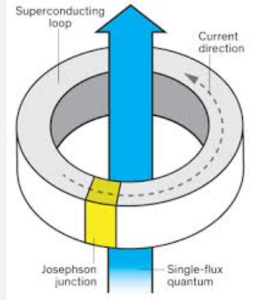
-
What is a Flux Quantum?
-
In a superconducting loop, magnetic flux is quantized in discrete units:

-
where h is Planck’s constant and e is the electron charge.
-
This quantization forms the basis of SFQ logic.
-
Working Principle of SFQ Circuits
-
SFQ circuits use Josephson junctions (two superconductors separated by a thin insulating barrier).
-
A single magnetic flux quantum pulse is generated when the phase difference across a Josephson junction changes by 2π2\pi.
-
Each pulse (lasting only a few picoseconds) represents a binary “1”, while the absence of a pulse represents a binary “0”.
-
Since these pulses are extremely short, SFQ circuits can operate at hundreds of gigahertz, far faster than traditional silicon circuits.
-
-
Types of SFQ Logic Families
-
RSFQ (Rapid Single Flux Quantum)
-
The first widely developed SFQ logic family.
-
Uses bias currents to support stable operation.
-
-
ERSFQ/eSFQ (Energy-Efficient SFQ)
-
Reduces static power dissipation by eliminating bias resistors.
-
-
RQL (Reciprocal Quantum Logic)
-
Uses AC power instead of DC bias, improving energy efficiency
-
-
-
Applications of SFQ Circuits
-
High-Speed Digital Electronics
-
Ultra-fast processors and signal processing systems.
-
-
Quantum Computing
-
Used in control and readout circuits for superconducting qubits.
-
-
Telecommunications
-
Ultra-fast routers, switches, and data transmission hardware.
-
-
Scientific Instruments
-
High-frequency detectors and precision measurement devices.
-
-
6. Superconducting Qubits
-
A Superconducting Qubit is a type of quantum bit built from superconducting circuits, typically using Josephson junctions. It is one of the most successful and widely used platforms for quantum computing, adopted by companies like IBM, Google, and Rigetti.
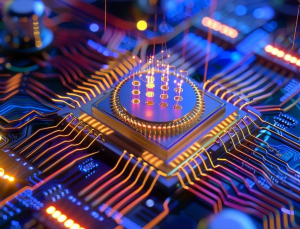
-
What is a Qubit?
-
A classical bit can only be in state 0 or 1.
-
A qubit can exist in a superposition of 0 and 1 at the same time, which allows quantum computers to process information in ways classical computers cannot.
-
-
Structure of a Superconducting Qubit
A superconducting qubit is made from:
-
Superconducting loop or circuit (made of materials like aluminum or niobium).
-
Josephson junctions, which provide nonlinearity essential for creating discrete energy levels.
-
Control lines for applying microwave pulses to manipulate states.
The Josephson junction prevents the circuit from behaving like a simple harmonic oscillator and instead gives it well-separated energy levels, which can be used to define the qubit states ∣0⟩|0\rangle and ∣1⟩|1\rangle.
-
-
Types of Superconducting Qubits
-
Charge Qubit
-
Based on the number of Cooper pairs on a superconducting island.
-
Sensitive to charge noise.
-
-
Flux Qubit
-
Uses the direction of persistent current in a superconducting loop as the qubit state.
-
Sensitive to magnetic noise.
-
-
Phase Qubit
-
Uses the phase difference across a Josephson junction.
-
-
Transmon Qubit (most popular today)
-
A modified charge qubit that reduces sensitivity to charge noise by increasing the Josephson energy.
-
Offers longer coherence times and is widely used in real quantum processors.
-
-
-
How Superconducting Qubits Work
-
The qubit states ∣0⟩|0\rangle and ∣1⟩|1\rangle are encoded in the quantized energy levels of the superconducting circuit.
-
Microwave pulses are applied to manipulate the qubit’s state, performing quantum gates.
-
Qubit measurement is done by coupling it to a superconducting resonator and detecting shifts in resonance.
-
-
Applications of Superconducting Qubits
-
Quantum Computing
-
Building scalable quantum processors.
-
-
Quantum Simulation
-
Modeling complex molecules and physical systems.
-
-
Quantum Communication
-
Interfacing with quantum networks via superconducting microwave photons.
-
-
Applications of Superconducting Devices
-
Medical Technology
MRI machines and MEG systems rely on superconducting magnets and SQUIDs. -
Energy Sector
Superconducting cables, transformers, and fault current limiters enhance efficiency and reliability in power grids. -
Transportation
Maglev (magnetic levitation) trains use superconducting magnets to achieve frictionless, high-speed travel. -
Scientific Research
Particle accelerators, such as the Large Hadron Collider (LHC), use superconducting magnets for beam steering. -
Quantum Computing
Superconducting qubits form the basis of cutting-edge quantum processors.
Challenges in Superconducting Devices
-
Cryogenic Cooling
Most superconductors require very low temperatures (close to absolute zero), demanding complex and costly cooling systems. -
Material Limitations
High-temperature superconductors (HTS) are promising but still face fabrication and stability challenges. -
Scalability
Integrating superconducting devices into large-scale commercial systems remains a challenge.
Future of Superconducting Devices
Advancements in high-temperature superconductors and cryogenic technology are making superconducting devices more practical and affordable. In the near future, these devices could enable:
-
Quantum computers capable of solving problems beyond classical machines.
-
Ultra-efficient power grids with minimal losses.
-
Advanced diagnostic tools in medicine.
-
High-speed, frictionless transportation systems.
Conclusion
Superconducting devices represent a breakthrough in modern science and engineering, merging the worlds of quantum mechanics and practical technology. While challenges like cooling and material costs remain, ongoing research promises to unlock their full potential. From medical imaging to quantum computing, superconducting devices are set to shape the future of technology in unprecedented ways.